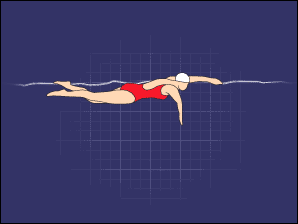Breastroke
To improve your speed through the water, your body position and power will play a big role.
Step One
- Breaststroke is not a very streamlined stroke so it is important to make the most of your body position whenever you can.
- Stretch out at the end of each stroke and make sure your arms are close and your legs are together, with your face in the water.
- To do breaststroke correctly you must make the body lift and drop.
- Practice lifting your shoulders and chest as your arms pull, so that your shoulders are clear of the water.
- You can also make your hips rise and fall slightly by kicking down into the water with the feet flat.
- When you bend your legs, try to make sure that your knees stay behind your body, and keep your feet slightly apart as you lift them to your bottom.
- This part of the kick is called the recovery because it gets the legs ready to kick again.
- Bend the elbows and keep them near the surface of the water as you start to circle with the hands.
- Then, as you finish the circle, tuck the elbows in to your chest.
- This ensures your hands are pulling towards your feet and makes your pull much stronger.
- You should now be swimming with your face in the water. Breathe out just before you lift your head.
- Take a breath with every stroke as your head lifts naturally and your arms pull back.
The backstoke is different to most strokes because you cannot see where you are going.
- It is difficult to keep your body traveling in a straight line if you don't kick your legs.
- Use long fast kicks, making sure your legs are moving up and down.
- Keep your knees underwater and bent a little, and your toes should make a small splash when you kick.
- The arms provide the power in back crawl, making a circling action as they move in and out of the water.
- You start by putting one arm in the water in a straight line above your shoulder.
- Once your hand is in the water it should push down and towards your feet. Bend your elbow slightly and pull your arm by your side to your thigh.
- Keep pushing your hand towards your feet until your elbow is straight. Then lift it out of the water, back to its original position and repeat the motion again.
- Keep the arm straight all of the time it is out of the water.
- The left and right arms do the same movement, but not at the same time. One should come out of the water at about the same time as the other enters it.
Butterfly needs both stamina and technique, but the body movements are not difficult because you will have done many of them before in other strokes.
- Both of your arms work at the same time and keep moving throughout the stroke.
- Put your hands in the water in front of your shoulders and pull them towards your feet.
- When your hands reach your thighs, lift them out of the water and throw them back to the start.
- You should keep your head in the water all the time, except when you need to breathe in.
- If you lift your head up at other times it will be almost impossible to get your arms over the water.
- The easiest way to breathe in is to push your chin forwards so that your mouth comes out of the water.
- It is best to do this when your arms are almost at your thighs.
The difficult part is getting everything in the right order, so:
- Kick your legs down as your hands go in
- Kick your legs down as your hands come out
- Keep your head down when your arms go over the water
- Keep your head down until your arms are near your thighs
- Breathe in quickly.
Front crawl is the fastest stroke and gives you the feeling of being powerful in the water.
Step One
- Swim with all of your body close to the surface of the water, keeping your hips and legs behind your shoulders.
- Imagine you are trying to swim through a narrow tube without touching the sides.
- A good way of doing this is to put your face in the water and keep your legs kicking all of the time.
Step Two
- Try to use long fast kicks, making sure all of your leg is moving up and down.
- Your knees should bend a little bit and your feet should make a small splash.
- Try counting to six quickly and kicking your legs in time with this.
Step Three
- Your arms provide the power for the stroke, so one arm should follow the other through the water and over the top.
- Try putting your hand into the water in front of your head and stretch it forwards as far as it will go, slicing it into the water with your thumb first - the less splash the better.
Step Four
- Increase your speed by bending your elbow and pushing your hand towards your feet, keeping it going until it reaches the top of your leg.
- Lift your arm out of the water and try to control it as it goes back to the starting point.
- Breathe regularly. Your face is in the water so you need to remember to turn your head when you want to take a breath.
- Try to turn your head smoothly, leaving the side of your head resting in the water.




















No comments:
Post a Comment